The Planes of IL-2 1946
Article Type: Military HistoryArticle Date: January 22, 2007
by Jim "Twitch" Tittle
The Planes of IL-2 1946
Great concept the 1946 thing. I've always enjoyed the "what if" idea that pitted planes which never met in combat against each other. LucasArts' Secret Weapons of the Luftwaffe did it first and so did Aces Over the Pacific later. Now Ubisoft and Oleg Mattox brings another gaggle of planes to the gaming table for our enjoyment.
While we might question the inclusion of these and not better models that existed at the time they will make a nice addition.
Let's look at some of the real world performance statistics of these planes.
Do 335V13One of the strangest designs was the Dornier Do 335A Pfeil (Arrow) that first flew in 1943. It had not only an in-line inverted V-DB 603G of 1,900 HP pulling it, but one pushing it as well. The front engine was cowled in a radial-style nose like the FW 190D instead of the normal taper like the Bf 109. The rear engine sat well ahead of the prop via and extension shaft. The tail was cruciform owing that it had a ventral stabilizer in addition to the vertical one. The span and length were equal at 45 feet making it look larger overall than it was. It sat on a tricycle landing gear.
Armament was substantial and variants had 15, 20 and 30MM cannons. The B-2 model in destroyer configuration had one Mk 103 30MM in each wing, and another firing through the prop shaft. Two 20MM MG 151s were placed in the upper cowl which supplanted the 15MM MG 151s on other models. Other projected Pfeils would have had two DB 603LA engines rated at 2,100 HP using two-stage superchargers and a larger wing of 60 feet.
The A-1 had a top speed of 474 MPH at 23,295 feet and initial climb of 2,165 FPM. Loaded the plane weighed 20,966 lbs. and could sortie to a range of 1,336 miles on internal fuel and 2,330 miles with external and climb to 37,400 feet. A second seat was added behind the pilot for a radar operator in the night fighter role variant. The initial aircraft snaked and porpoised somewhat at high speed. Envisaged as a heavy day/night fighter only eleven single and two two-seat production aircraft were delivered and none probably saw action before the war's end. Actually this odd configuration probably would have been more successful than the standard layout twin-engine ships the Luftwaffe used owning to the high-powered engines and more compact size.
The V13 prototype used the Daimler-Benz 603E-1 V-12 giving 1,900 HP. And differed from the A-1 by mounting a 30MM Mk 103 cannon in each wing along with the pair of MG 151 20MMs.
Ta 152CFocke Wulf's Kurt Tank took the excellent qualities of the FW 190 and came up with the FW 190D replacing the radial BMW with a Junkers Jumo V-12. Going one step further they came up with the Ta 152C using the Daimler Benz DB 603E with 1,800 take off horsepower. Using the DB 603LA with MW-50 methanol-water boost raised power to 2,300 HP.
The addition of GM 1 nitrous oxide gave the fighter a top speed of 463 MPH at 34,400 feet and a ceiling of 40,350 feet. Initial climb was 3,050 FPM. Range was 684 miles. Its wings spanned 36 feet and it was 35.5 feet long. It weighed 11,508 lbs. loaded.
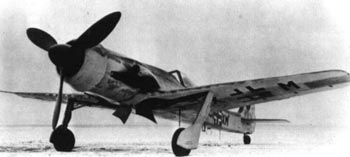 |
| Ta152C |
Armament was heavy with a 30MM MK 103 or MK 108 engine mounted. A pair of 20MM MG 151 graced the upper cowl of the fuselage and another pair rested in the wings.
Though only a handful of this and the Ta 152H were constructed they represent a true milestone in piston fighters.
MiG-13Mixed power was not the exclusive property of Germany, which saw many combinations of motive thrust in its designs. In Russia some La-7 and 9s were produced with liquid fuel rockets in the rear fuselage for combat boost but the ramjet seemed to hold more promise.
In 1943 Artem Mikoyan began work on a fighter using a V-12 to pull it and a ramjet to push it. A Klimov VK-107A 0f 1,650 HP drove a 3-bladed prop and a compressor to boost airflow to a rear-mount ramjet. The pilot sat well back at the wing's trailing edge of the 26.9-foot fuselage of the loaded 8,666-lb. plane. Wingspan was just 31.1 feet.
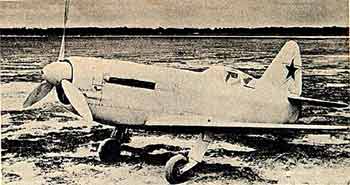 |
| MiG-13 |
The I-250 (N) flew in March 1945 and hit 497 MPH. The ramjet provided an additional 660 lbs. of thrust translating to 62 MPH for ten minutes. The ship could attain 385 MPH at sea level and 513 MPH at 22,965 feet. Time to 16,405 feet took 3.9 minutes and a ceiling of 39,240 feet was achieved with a range of 857 miles.
Three 20MM G-20 cannon were used. One sat between the cylinder banks with the others alongside the engine.
With collapse of Germany and the wealth of technical data retrieved, designs of pure jet were emphasized and Mikoyan concentrated on the future MiG 9 jet design. The I-250 was designated MiG 13 and sixteen were produced but were retired by 1948.
LaGG-7RThis was an earlier take on mixed power combos. Two La-7 airframes were modified to accept the 660 lb. thrust RD-1KhZ liquid fuel rocket in the aft fuselage as La-120Rs.
The typical La-7 used a 1,700 HP Shevetsov M-82FN 14-cylinder radial good for 423 MPH at 19,030 feet. Cutting in the rocket produced a top end of 10-15% greater. 16,400 feet was reached in 4.5 minutes. Ceiling was some 34,448 feet.
 |
| La-7R |
It was capable of a range of 615 miles. The wings spanned 32.1 feet and it was 27.9 feet long weighing in at 7,496 lbs. on the runway.
After abandoning work on the LA-7R Lavochkin commenced the all new La-126 which used the same piston engine but employed a pair of Bondaryuk VRD-430 ramjets giving a top speed of 497 MPH at 26,245 feet.
Yak-3 VK-107-AYakovlev developed the 3 alongside the Yak-9 actually. It was put in service in 1943. The VK-107-A hit the skies in 1945. It was light on the ailerons and had a high initial climb and speed at its operational altitudes of 8-11,000 feet due to the Klimov KV-107A V-12 putting out 1,650 HP. A top speed of nearly 450 MPH at 18,500 feet was the result.
A ceiling of 36,600 feet could be reached in 24.7 minutes and 15,500 feet was hit in 3.9 minutes.
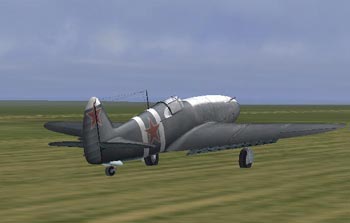 |
| Yak03 |
A pair of B-20S 20MM cannon with 120 RPG fired through the prop arc. Later one B-20M 20MM fired through the prop hub with 100 rounds was added.
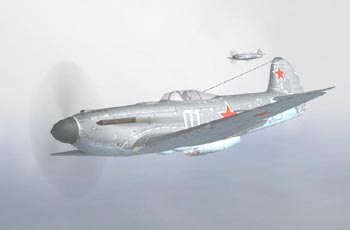 |
| VK-107 |
It was a compact fighter with a wingspan of just 30.1 feet and was 27.9 feet long. It weighed just 6,248 lbs. loaded and could travel about 405-620 miles depending on date of manufacture.
Some 100 were built.
LaGG-3RTo tell you the truth I can find no listing anywhere of a Lavochkin LaGG-3R. It must be extremely obscure. The best LaGG-3 with its 1,210 Klimov M-105PF V-12 was phased out for the LaGG-5 in 1942. At any rate its top speed of 373 MPH at 16,400 feet was adequate for its purpose. It had an initial climb of 2,953 FPM and could reach 31,496 MPH.
Range clean was 404 miles and increased to 497 miles with two 22-gallon drop tanks.
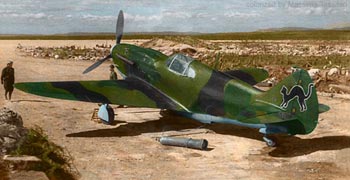 |
| LaGG-3 |
Typical armament was a ShVAK 20MM firing through the prop hub with 120 rounds and a pair of Beresin 12.7MM machineguns with 220 RPG. Various arrangements of 7.62MMs and even 23MM cannon were used. Light bombs could be carried.
The fighter weighed 6,843 lbs. loaded and had a 32.1-foot span while it was 29.1 feet long.
One example was fitted with a 1,650 HP Klimov M-107A and performance is unknown but likely exceeded the standard model handily. If this is the 3R it should be lively.
LaGG-3RDThis is almost a lost number in the annals of the Soviet air arm. Seemingly its concept was the placement of a Jumo turbine into the basic Lagg-3 airframe. This evolved into the La-150 and then the La-152. Performance is unknown concerning the Frankensteined Lagg-3/Jumo combo but the La-152 using the 1,984 lb. thrust RD-10 could manage 483 MPH at 16,405 feet. That altitude was attained in 6.5 minutes. It could travel 306 miles.
Armament was two Vya 23MM cannon. The small plane's span was just 26.9 feet and it was 29.9 feet long weighing in at 7,140 lbs. on the flight line.
One was built and the following re-engined prototypes were designated the LA-154 and La-156 respectively. Using the RD-10F afterburning turbine it attained a speed of 562 MPH.
MiG 9FS & F-2Initially under the I-300 designation the MiG 9 looked like a typical German design in the early turbine era. In fact it used a pair of BMW 003A of 1,760 lbs thrust each. A later pair of indigenous RD-20s were mounted and the ship was re-designated the I-301T.
A pair of Vya 23MMs and one 37MM Ns-OKB-16 cannon armed the fighter. By 1947 two RD-21Fs with 2,205 lbs. thrust each gave a speed of 590 MPH at 16,405 feet attaining that height in 2.7 minutes in the prototype FF(I-307). This corresponds to the sim's F-2.
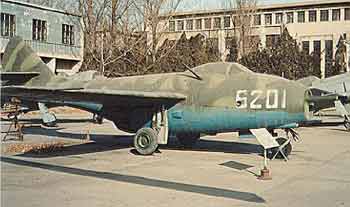 |
| MiG-9 |
The production FS had a span of 32.8 feet and length of 32.25 feet. It could hit 566 MPH at 14,765 feet with climb to 16,405 in 4.3 minutes. Range was 497 miles with a loaded weight of 10,941 lbs.
604 were built.
Yak-15As a stable mate of the MiG-9 we will see the Yakovlev Yak-15. It too is a German concept that used a Junker Jumo 004B for power initially. The turbine mounted below and a bit forward of the cockpit giving it a fat front-slim aft look.
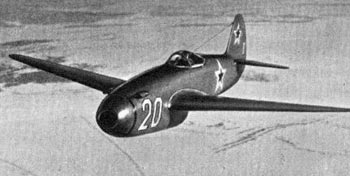 |
| Yak-15 |
It was lighter that the MiG-9 at just 6,029 lbs. with a span of 30.1 feet and a length of 28.5 feet. Relatively it carried less armament with a pair of Vya 23MM cannon. It could only hit 500 MPH at 16,405 feet taking 4.8 minutes to reach that altitude. Range was equally short at 317 miles.
The type saw 280 examples built before it made way for the Yak-17 which was quite similar.
Bi-6A real oddity will be the Bereznyak-Isaev BI-6 rocket plane designed by Alexsandr Bereznyak and Alesksei Isaev. A series of 8 planes were built beginning in 1941 with the BI-6 using wing tip ram jets boosters. Though it was never flown the BI-2 could climb to 10,000 feet in 59 seconds.
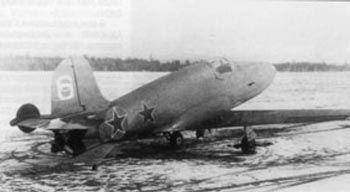 |
| Bereznyak-Isaev Rocket Plane |
A RNII D-1A-110 liquid bi-fuel rocket motor of 2,425 lbs. thrust was to give a top end of 559 MPH for 15 powered minutes. The tiny 3,710-lb. fighter, akin to the Me-163, would glide back to earth landing on retractable skis or wheels. It was only 21 feet long with a span of 21.25 feet.
A pair of 20MM cannon in the nose comprised the armament.
The BI-3 exhibited a dangerous tendency to pitch its nose violently down at speed. This along with tail vibration from the ramjets did the project in and the 50 production planes conceived were never begun.
Me-262HG-IIThe original concept was that of a 2-seater with a radar operator in back. The fuselage was almost the same as the original, the tail was a "vee" shape and the wings were radically new. The HeS engines mounted as did the standard 262's but on the later HG- 3 they didn't hang under the wing like an afterthought. On the HG-3 they would blend in above the wing and were married to the fuselage. The wing, which was swept at 18-degrees on the operational 262, now had an extreme 43-degree sweep. The 262 went from sleek to slick and was more graceful to the eye.
But function was the intent and the HG series wing and engines would have been good for 621 MPH. Dimensions are generally similar to the Me 262A but not known exactly. The four Mk 108 30MM cannon were to be retained. A clean-looking single-seat HG-III was planned featuring engines buried at the juncture of the fuselage and wing root. And a forward-mounted cockpit was designed for the basic 262 in the Schnellbomber Ia (Fast Bomber) layout.
As we flash forward to the waning days of WW II, the P.262 HG-2 was in final prototype stage actually waiting for takeoff clearance when an aircraft in an emergency landing clipped it. The fire that ensued destroyed the P-262 HG-2. The Russians obtained the blueprints and built their version of the Me 262 in the late 1946 as the Sukhoi Su-9 following with the Su-11 in 1947. Performance for the Su-9 was similar to the standard Me 262 and the Su-11's was a bit better. Both used hung-below-the-wing engines as the 262 did.
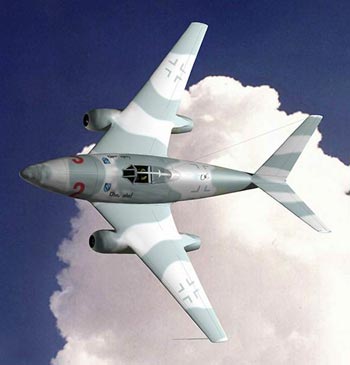 |
| HG-III |
The P-262 HG-II was certainly a contender for real production status given the Fürher's close relationship with Willy Messerschmitt. It could have soon been in the skies above Germany. The performance and other specs are lost to history but with about 2,000 lbs. more thrust and no external engine drag it on the HG-III would have been in the estimated 621 MPH range no doubt.
Ta-183Kurt Tank of Focke Wulf had a superb designer in the persona of Hans Multhopp who laid out the Ta-183 Huckelbein.
His project P.183 was accepted in February 1945 and was to be 9,480 lbs. loaded with a 40-degree swept span of 32.8 feet and length of 30.1 feet. Tail planes were equally swept with the characteristic horizontal stabilizer at the upper extreme of the vertical forming a "T." Wing area was 242 square feet compared to the MiG 15's 186 square feet. One HeS 011 of 2,866 lbs. thrust was the main power but a HWK 509 bi-fuel liquid fuel rocket of 4,409 lbs. thrust was to be used additionally in the interceptor role adding its boost for 3.5 minutes.
It was to fill the "Emergency Fighter" role set down by the Air Ministry and production was ordered off the drawing board. Its design made it small and as simple as possible to build. Armor protected the fuel tanks and pilot against 20 mm rounds. It could carry 1,102 lbs. bombs or a torpedo as needed. Multhopp figured for two Mk 108 30MMs with 120 RPG in the nose and two more with 60 RPG were optional.
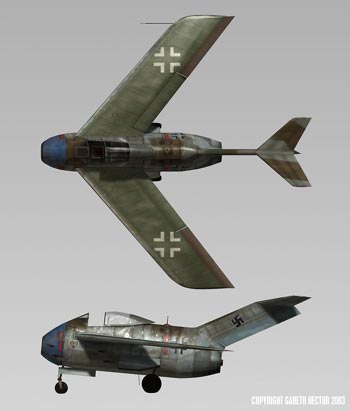 |
| Ta-183 |
Performance estimates seem quite unembellished with a top speed of 575-597 MPH at 9,843 feet. A 348-mile dash range at 100 percent throttle at sea level was assumed from its 345 internal gallons but 1,150 miles was to be traveled carrying external fuel at economical speeds at 22,967 feet. The projected ceiling of 47,200 feet was reasonable. Climb was approximated at 4,800 FPM initially and slowing to 3,240 FPM at 19,700 feet. All speed and climb figures do not factor in the rocket motor. Speed estimates with the rocket are uncalculated but with thrust on par with a MiG 17. So make your own estimate.
Project P.183 became the Ta 183 as it was accepted in February 1945 and was to be 9,480 lbs. loaded with a 40-degree swept span of 32.8 feet and length of 30.1 feet. Tail planes were equally swept with the characteristic horizontal stabilizer at the upper extreme of the vertical forming a "T." Wing area was 242 square feet compared to the MiG 15's 186 square feet. One HeS 011 of 2,866 lbs. thrust was the main power but a HWK 509 bi-fuel liquid fuel rocket of 4,409 lbs. thrust was to be used additionally in the interceptor role adding its boost for 3.5 minutes.
The Ta-183 carried the wire-guided X-4 missiles we'll describe next.
Ruhrstahl/Kramer X-4The Ruhrstahl X-4 air-to-air weapon was really sci-fi in April of 1944 when it was first tested. This was a wire-guided weapon, and as are today's descendants, un-jam-able. The SD 1400 Xs and Hs 293s were effectively diverted from targets by Allied jamming later in the Mediterranean. The X-4 received its course corrections through it 3.5-mile long cables as they un-spooled. No countermeasures were then or are now effective.
Sighting and steering was accomplished with a PKS-12 gun sight in conjunction with the Dusseldorf/Detmold command link's tiny joystick. The 242 lb. thrust BMW 109-448 rocket propelled the six foot long, 132 lb. missiles at 520 MPH to targets and the large 44 lb. warhead was detonated with a Kranich acoustic proximity fuse tuned to the frequency of the B-17's engines where it would explode at about twenty feet distant. The 2.8-foot wing fins gave stability. The fuel burned for seventeen seconds. It was SV-stoff and R-stoff or Tonka-250 mixing equal amounts of xylidine and triethylamine.
The BMW plant was destroyed in bombings but not before 1,300 were produced. No X-4s were confirmed to be used by the Me 262 for which it was intended though some reached operational units. The X-4 was a "second" away from use and would have caused some damage to the bomber stream.
The Hs 298 missile lost out to the X-4 but had some merits. The first launch of an Hs 298 was on December 22, 1944 from a Ju 88 A-4. More than 300 Hs 298 missiles were fired during extensive testing at Karlshagen from Ju 88G, Ju 388, and FW 190s. It weighed 200 lbs. with its 55 lb. warhead. Length of the oval fuselage was 6.6 feet while the wing spanned a rather large 4.3 feet. It had a twin fin tail for control with input from the Kehl/Colmar command link. This is where it lost out to the X-4 in that attack parameters specified a no more than a 30-degree variant from astern while being 15-degrees below. The X-4 could be guided in any direction or attitude from the launch aircraft.
He-LIII-B LERCHEWhen Allied bombing made Swiss cheese of Luftwaffe runways a new concept was discussed in VTOL- vertical take-off/landing fighters.
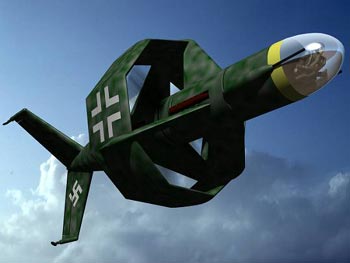 |
| Lerche |
The Heinkel Lerche II (Lark) was a variation on the Heinkel turbo-prop VTOL Wespe in that the pilot lay prone in level flight and stood on landing, possibly to gauge touch down better and to take greater G-forces, from a completely Plexiglas nose of the 30.9-foot, 5,600-pound craft. Final blueprints came out in early March 1945. They called for the use of two 2,000 HP DB605Ds mounted in tandem driving contra-rotating props to provide lift and forward propulsion. The prop shroud/wing measured 13-feet. Range again is a question mark but speed was calculated to "be in excess of 497 MPH." Two 30MMs protruded alongside the nose bubble.
He 162Before the Heinkel 162 was in service designs for rearward and forward swept wings was alive. Another variation saw a steeper dihedral with turned down tips.
The standard He 162 with the BMW 003 A-1, A-2 or E-1, E-2 with 1,760 lbs. thrust the tiny craft could hit 562 MPH at 19,700 feet and 553 MPH at sea level in 30-second over-boosts with 2,028 lbs. of thrust. At normal thrust speeds were 522 and 490 MPH respectively. Initial climb was 4,615 FPM. At of 36,000 feet a maximum range of 606 miles could be attained. The loaded weight measured 5,480 lbs. Span was 23.65 feet and length was 29.75 feet. With two 20MM MG 151s it carried 120 RPG and with the two 30MM Mk 108s it was 50 RPG.
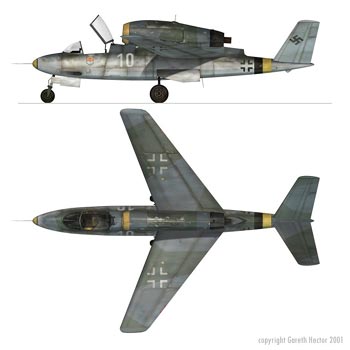 |
| He-162D |
The proposed BMW 003R combined jet/rocket BMW-718 liquid fuel booster could have propelled the 162 to 628 MPH at sea level. The definitive power plant was to have been the forthcoming all jet Heinkel HeS11 of 2,860 lb. thrust with a V-type tail and wings swept back (He-162C) or forward (He-162D) as mentioned.
Ar 234BThe first operational jet bomber/recon ship was the Ar 234B. Powered by a pair of Junker Jumo 004Bs with 1,980 lbs thrust each it could manage 461 MPH clean at 19,865 feet. It had a ceiling of 23,810 feet. Operations began in November 1944.
I had a pressurized cabin that sported a periscopic bombsight to deliver its 550 or 1,100-lb. bombs. At maximum 3,300 lbs. could be attached. The bomb periscope could be turned to sight in a pair of MG 151 20MM cannon with 200 RPG that fired aft.
Clean it could travel 1,013 miles. With 1,100 or 3,300 lbs. of ordnance it could manage 967 and 683 miles respectively. With 1,100 lbs. hung below it would climb to 19,685 feet in 21.8 minutes.
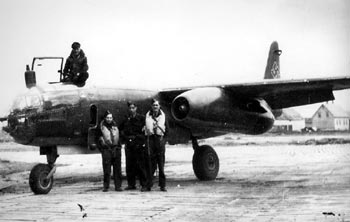 |
| Ar 234B |
The 234B was relatively small weighing 18,541 lbs. without ordnance. Wing span was just 46.25 feet while length was 41.4 feet.
Provision for two Walter HWK 109-500 RATO (rocket assist take-off) units of 1,102 lbs. thrust each gave 30 seconds of power.
If the Arado Ar 234B Blitz (Lightning) was not enough with its 461 MPH speed and 3,300-lb. bomb load the Ar 234C would have been. "B" models were already flying with impunity over England on recon flights at 39,000 feet and used in the Ardennes (Battle of the Bulge) Counteroffensive in the winter of 1944-45. The 234's airframe was engineered to take more power than the two Jumo 004Bs had with their 1,980 lb. thrust. The next configuration was that of four BMW 003A turbojets with 1,760 lbs. thrust each mounted each in its own pod beneath the 46-foot wings. The arrived upon layout however was that one nacelle housing two engines.
The nineteen Ar 234Cs built could and did fly recon missions at 42,000 feet and hit 542 MPH down at 19,700 feet. On internal fuel it could manage a 920-mile range though its two 66-gallon tanks would extend that. Climb to 32,810 feet was only 11.9 minutes. The single-seat recon/bomber weighed only 20,600 lbs loaded. Bomb load was the same as the "B" and the two 20 mm tail guns with 250 RPG fired by the pilot using a periscope were retained but two more Mg 151 20MMs with 250 RPG were added to fire forward.
Beyond that was a scheme to tow with a semi-rigid tube or mount piggy-back above the fuselage, an 880-gallon tank that would greatly extend the range to some 1,800-2,000 miles maximum. This was a forerunner of the B-58's detachable fuel/weapon pod it carried on the belly seen years later.
This developed into the work-up for a Fi 103 (V-1) to be attached in the same manner and towing of an Hs 294 air-to-surface guided bomb. With an Hs 294 in tow the Ar 234C could still make 510 MPH at 26,250 feet.
In advanced assembly were the two and three-man "P' series with night fighting radar and assorted mixes of 20 and 30MM cannons including the oblique mount of the Schräge Musik (slanted music). Let's remember, the Arado 234 actually saw service at the waning moment of WW II making it the world's first jet bomber in service.
On the Arado drawing board was the swept-wing E.560/4 bomber with four BMW 003E turbojets each with 2,646 lbs. thrust each that would put it in the near 600 MPH speed range and able to travel about 1,300 miles. The E.560/11 proposed using four BMW 018 each with 5,071 lbs. thrust with speeds and ranges we can only guess.
Though there is but one Ar 234 left there are really more. Get your shovel if you want one since several were buried at the end of the NAS Patuxent River in the 1960s!
The 210 Ar 234Bs saw limited service during the closing stages of the war and subsequent models were getting ready for production. The bridge at Remagen was attacked by Ar 234Bs. It looked quite un-futuristic and logical overall.
As an author of war and air combat related writings I have had the fortune to meet and discuss such things with a large number of aces and others from the US, Great Britain, Germany, Russia and a couple from Japan. Beginning in the early 1980s I was a member of various organizations that brought aces to the US from the other countries for air combat discussion symposiums and conventions. I found it quite easy to get questions answered along with lengthy explanations of combat missions for my tape recorder. Fighter pilots love to talk! Fortunately I have talked to the likes of Adolf Galland, Johnnie Johnson, Gabby Gabreski and Asrenii Vorozheykin.
This comes from a life long interest in World War II aircraft and the pilots that flew them. My own father earned his wings at the end of the war and was just getting into P-51s when the conflict ended. I obtained my first books on the subject in the late 1950s as a kid and built up a library of hundreds of books since.
I draw my subject matter from the men that flew the planes and my collection of books.
